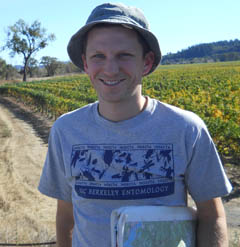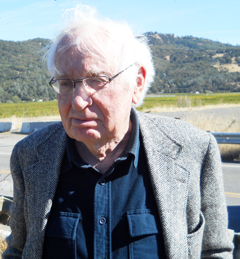
|

Download the ISRP Report:
Russian River ISRP Public Meeting Presentations and Videos
VIDEO: Study Introduction and Meeting Overview
VIDEO: Overview and History of the Russian River Watershed
VIDEO: Surface and Groundwater Interactions
VIDEO: Conceptual Model of Stream Flow Processes for the Russian River Watershed
VIDEO: Channel Typology and Salmonids
VIDEO: Data Gaps
VIDEO: Recommendations
|

|
Local Organizations Form Russian River Science Panel
A group of local water suppliers and agricultural and watershed organizations have established the Russian River Independent Science Review Panel in an effort to establish a sound scientific basis for future water supply and watershed management decision making in the Russian River.
The new Panel will provide objective scientific review and recommendations on watershed monitoring, water management, the agriculture frost protection programs and implementation of the lower summer minimum in-stream flows specified in the federal Russian River Biological Opinion on Salmon and Steelhead. To better understand physical and ecological processes in the basin, the Panel will collect and review existing data, identify data gaps, review water management efforts, and develop a conceptual model that systematically describes physical processes and associated ecological processes in the river system.
To date, there has been no systematic, basin-wide assessment of the physical processes in each tributary to determine controls on surface flows and primary limiting factors for salmonid habitatssaid Dr. Matt Kondolf of the University of California at Berkeley and Chair of the Panel. Data are lacking from most of the watershed, but even the data that exist have not been systematically used to their potential.
Phase 1 of the Panel's work will focus on the Coyote Dam to Healdsburg area of the watershed and the Mark West and Green Valley Creek tributary basins. Subsequent work will be focused on other portions of the watershed.
|
|

|
Panel Composition
Over 16 applications for the Panel were reviewed by a team of local leaders made up of representatives from:
- The Sonoma County Water Agency
- Mendocino County Russian River Flood Control and Water Conservation District
- Sonoma County Water Coalition
- National Marine Fisheries Service and
- two agricultural representatives, one from Sonoma and one from Mendocino county
Eight membersand a chairman were choosen to serve on the Panel, whose scientific areas include geology, aquatic ecology, fish biology and sustainable business practices.
The ISRP members include:
|
 |
Dr. Matt Kondolf, fluvial geomorphologist and Professor of Environmental Planning at UC Berkeley
His work focuses on river management, human alterations to river systems including dams, dredging, and gravel mining and science based restoration strategies that rely on an understanding of river processes. Matt has been working with the Ca Land Stewardship Institute on the ISRP concept for 3 years and will chair the panel. |
 |
Dr. Matthew Cover, Assistant Professor of Ecology at CSU, Stanislaus.
His background is in watershed ecology and the effects of watershed disturbances on stream ecosystems, especially for salmonids and aquatic insects. Project watersheds include the Klamath, San Francisco Bay Area and Eastern Sierra. |
 |
Dr. Richard Adams, Professor Emeritus of Agricultural and Resource Economics at Oregon State University
His expertise is in resource and environmental economics with emphasis on water resource management, economics of species and habitat investments, and the value of information in policy making. His recent projects include a study of the economic costs of alternative steelhead habitat improvements in Napa County. |
 |
Mr. Christopher Farrar, retired U. S. Geologic Survey employee
He focused on hydrogeology and his recent projects include hydrologic and water quality studies in Sonoma Valley, Alexander Valley, and the Santa Rosa Plain and developing groundwater models for Sonoma Valley and the Santa Rosa Plain. |
 |
Dr. F. Douglas Shields, Jr., Consulting Hydraulic Engineer and retired from the National Sedimentation Laboratory
His research focuses on stream restoration and river corridor management especially the effects of human development on fluvial systems and environmental design criteria for channel stabilization and modification projects. Project locations range from the Lower Mississippi River, the Missouri River and the Sacramento River to many smaller streams in between. |
 |
Dr. James Constantz, Research Hydrologist at the National Research Program at the U. S. Geologic Survey
His research focuses on surface and groundwater interactions and he is the leading authority on the use of heat and other natural tracers for monitoring these interactions. |
 |
Dr. John Bredehoeft,consulting Hydrogeologist, after retiring as a Senior Research Geologist from the U. S. Geologic Survey
His expertise is in water resources, particularly groundwater-surface water interaction. Projects include flow and contaminant transport models, economic studies of ground and surface water use, hydrodynamics of deep sedimentary basins and impacts of groundwater pumping on the flow of rivers. |
 |
Dr. Vincent Resh, Professor of Entomology at UC Berkeley
His research focused on monitoring of aquatic systems, multi-jurisdictional water management and aquatic ecology. He is a member of the Science Advisory Board of the Delta Stewardship Council, Chief Consultant on Evaluation of Ecosystem Health and Monitoring for the Mekong River Commission. |
 |
Dr. Michael Marchetti, Professor of Ecology at St. Mary’s College of California with a focus on Aquatic Ecology and Fisheries Biology
His past projects involved invasive aquatic species in California, native fish ecology, impacts of flow regulation and suspended sediment on aquatic biota, and food web issues for salmon in the Central Valley. |
Assistants |
|
 |
Mr. Scott Walls |
 |
Dr. Fernando Magdelano |
Background
The Russian River Watershed encompasses one million acres and supports a wide variety of land uses and natural habitats. The listing of steelhead trout, Coho and Chinook salmon as threatened and endangered species has placed a greater emphasis on water supply, use and management. An understanding of the geomorphic and hydrologic context of the Russian River and its tributaries suggests that there are numerous factors influencing the amount of water in the river and tributary streams. There are strong interactions between surface flow and groundwater resulting from the geomorphic setting and recent history. Data on shallow groundwater levels, and their relation to surface flows, are sparse.
Because flows in Russian River tributaries are affected by geomorphic and hydrologic factors in a complex way, improved data are needed to develop a scientifically sound management approach to protect native fish in these waters. In an effort to develop a scientifically defensible basis for managing water diversions in the Russian River watershed, the Sonoma County Water Agency, Mendocino County Russian River Flood Control and Water Conservation Improvement District, and the California Land Stewardship Institute have agreed to form a Russian River Independent Science Review Panel (ISRP). The ISRP will provide objective scientific review and recommendations on monitoring, and water management. Phase 1 of the ISRP's work will focus on the Coyote Valley Dam to Healdsburg area of the watershed along with the Mark West and Green Valley Creek watersheds. Dr. Matt Kondolf of the UC Berkeley will chair the ISRP.
|

|

The Russian River

Stream staff gage
 Gage house Gage house
|
Duties and Responsibilities
Review existing information to characterize the Russian River drainage, and its hydrologic and ecological processes, and identify important data gaps.
A UC Berkeley graduate student is currently compiling this information.
Develop conceptual scientific models of hydrologic and geomorphic processes in the included regions of the watershed.
Within these regions, the conceptual models would articulate flow processes for stream reaches as defined by geomorphic features including canyon streams, alluvial fans, alluvial channels, incised channels and the relationship of tributary stream flow processes to the Russian River mainstem.
Surface to groundwater interactions will be a particular focus, taking into account effects of flow regulation by the operation of Coyote Valley Dam on the mainstream of the Russian River, in addition to surface water diversions and groundwater use by municipalities, water purveyors, agriculture, and residential well owners. Also, the effects of diversions on tributaries will be evaluated.
The models will link ecological processes with hydrologic/geomorphic processes and thereby trace the underlying causes of changes affecting salmonid habitats.
Participate in a two day Science Forum with the objective of gathering all stakeholders from the scientific community in order to gather and share data and ideas related to the Russian River watershed.
Participate in a community stakeholder meeting for non-scientist stakeholders, community members, elected officials and policy makers, where the ISRP will present their findings, methods, studies and discuss scientific concepts in terms understandable to the non-scientist.
Review monitoring programs in various tributaries, including monitoring protocols, QA/QC procedures, tributary selection and station locations.
Review collected data to formulate conclusions and define additional monitoring needs and potential water management actions.
Complete a summary report of findings, which will provide the public with a record of the ISRP's activities.
Meet at least twice, and up to four times, a year as needed for a two year period with a likely extension to 5 years. Field tours of the watershed will be included. |
ISRP Application and Selection Process
|
ISRP applicants were reviewed for their education, qualifications, experience with the relevant scientific fields, and their experience working in interdisciplinary projects and panels.
ISRP applicants are not expected to have extensive experience in the Russian River basin, but rather to have expertise in the scientific issues important in the Russian River basin, as one goal of the ISRP is to take a fresh look at some of the technical issues in the watershed.
ISRP applicants were reviewed for conflicts of interest involving financial connections to the winegrape industry in the Russian River watershed, to environmental organizations, to water agencies, or to the regulatory agencies directly involved in water issues in the Russian River watershed.
The ISRP members are largely free of financial ties to parties involved in water issues in the basin.
|

ISRP Chair
Dr. G. Mathias Kondolf,
University of California, Berkeley
|
Relevant Publications, Reports, and Data Matrix
For more information contact:
Russian River Independent Science Review Panel
550 Gateway Dr., Suite 108
Napa, CA 94558
Phone: (707) 253-1226
Fax: (707) 253-1708
E-mail:
info@russianriverisrp.org
|
|


